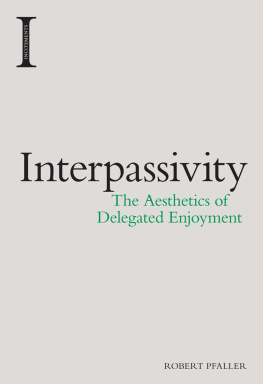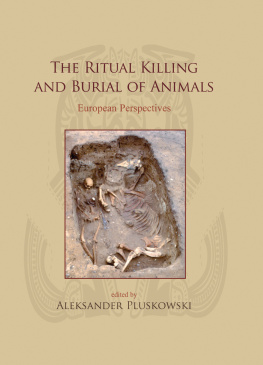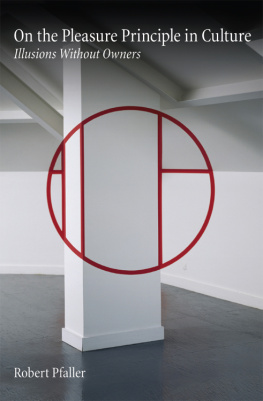Interpassivity
The Aesthetics of Delegated Enjoyment
Robert Pfaller

Edinburgh University Press is one of the leading university presses in the UK. We publish academic books and journals in our selected subject areas across the humanities and social sciences, combining cutting-edge scholarship with high editorial and production values to produce academic works of lasting importance. For more information visit our website: edinburghuniversitypress.com
Robert Pfaller, 2017
Edinburgh University Press Ltd
The Tun Holyrood Road, 12(2f) Jacksons Entry, Edinburgh EH8 8PJ
A CIP record for this book is available from the British Library
ISBN 978 1 4744 2295 6 (epub)
The right of Robert Pfaller to be identified as the author of this work has been asserted in accordance with the Copyright, Designs and Patents Act 1988, and the Copyright and Related Rights Regulations 2003 (SI No. 2498).
Contents
Acknowledgements
Introduction: Interpassivity Today an earlier version of this text was published in German in Robert Pfaller, sthetik der Interpassvitt, Hamburg: philo fine arts, 2008. Translated from German by Lisa Rosenblatt.
1 The Work of Art that Observes Itself: The Aesthetics of Interpassivity first published in Italian in Agalma. Rivista di studi culturali e di estetica 78 (March 2004): 6274.
2 The Parasites of Parricide. Living through the Other when Killing the Father: Interpassivity in The Brothers Karamazov talk given at the dance performance, Brothers Karamazov volume 1, directed by Mateja Bucar, Ljubljana, Slovenia, 202 December 2006; festival Fabbrica Europa, Florence, Italy, 89 May 2007, cf. http://www.dum-club.si/mateja/karamazov1/karamazov1.htm (last accessed 11 November 2016). Earlier version published in German in Robert Pfaller, sthetik der Interpassvitt, Hamburg: philo fine arts, 2008, 1305.
3 Little Gestures of Disappearance: Interpassivity and the Theory of Ritual published in English in Journal of European Psychoanalysis, Humanities, Philosophy, Psychotherapies 16 (WinterSpring 2003/4): 316.
4 Interpassivity and Misdemeanours: The Art of Thinking in Examples and the iekian Toolbox first presented at the annual meeting of the British Society of Phenomenology, St Hildas College, Oxford, 7 April 2006. Published in English (and Chinese) in International Journal of iek Studies 1.1, special issue Why iek? (2007): 3050. Translated from German by Astrid Hager.
5 Against Participation published in German and English in Susanne Jakob (ed.), Risiko Curating & weitere Projekte. Zwischen Intervention und Partizipation, Stuttgart: Kunstverein Neuhausen, 2007, 3749 (exhibition catalogue). Translated from German by Rebecca van Dyck.
6 Matters of Generosity: On Art and Love published in Slovenian and English in maska XXVII.1478 (2012): 12433 (Slovene cultural journal).
7 What Reveals the Taste of the City: The Ethics of Urbanity published in English in Urbanity. The Discrete Symptoms of Privatization and the Loss of Urbanity, ed. content.associates, Vienna: content.associates, 2013, 3046 (conference report). Translated from German by Eric Scott.
Incitements
Series editors
Peg Birmingham, DePaul University
and Dimitris Vardoulakis, Western Sydney University
Editorial Advisory Board
tienne Balibar, Andrew Benjamin, Jay M. Bernstein, Rosi Braidotti, Wendy Brown, Judith Butler, Adriana Cavarero, Howard Caygill, Rebecca Comay, Joan Copjec, Simon Critchley, Costas Douzinas, Peter Fenves, Christopher Fynsk, Moira Gatens, Gregg Lambert, Leonard Lawlor, Genevieve Lloyd, Catherine Malabou, James Martel, Christoph Menke, Warren Montag, Michael Naas, Antonio Negri, Kelly Oliver, Paul Patton, Anson Rabinbach, Gerhard Richter, Martin Saar, Miguel Vatter, Gianni Vattimo, Santiago Zabala
Available
Return Statements: The Return of Religion in Contemporary Philosophy
Gregg Lambert
The Refusal of Politics
Laurent Dubreuil, translated by Cory Browning
Plastic Sovereignties: Agamben and the Politics of Aesthetics
Arne De Boever
From Violence to Speaking Out:
Apocalypse and Expression in Foucault, Derrida and Deleuze
Leonard Lawlor
Agonistic Mourning: Political Dissidence and the Women in Black
Athena Athanasiou
Interpassivity: The Aesthetics of Delegated Enjoyment
Robert Pfaller
Derridas Secret: Perjury, Testimony, Oath
Charles Barbour
Resistance and Psychoanalysis
Simon Morgan Wortham
Visit the series web page at: edinburghuniversitypress.com/series/incite
Introduction: Interpassivity Today
Interpassivity is a widespread, and yet mostly unacknowledged, form of cultural behaviour. Rather than letting others (other people, animals, machines, etc.) work in your place, interpassive behaviour entails letting others consume in your place. We can speak of interpassivity when people, for instance, insist that others drink their beer for them, or when they let recording devices watch TV programmes in their place, or when they print out texts instead of reading them, or when they use ritual machines that pray or believe for them vicariously (ora pro nobis), or are happy that certain TV shows feature canned laughter that displays amusement in their place. Clearly, not all of these multiple social practices and individual behaviours are necessarily interpassive. However, I would claim that without a concept of interpassivity, many of these practices and behaviours cannot be sufficiently explained. Without the concept of interpassivity, we cannot grasp the ways in which these practices are grounded in the preference of particular subjects for delegating their enjoyment rather than having it themselves.
Rather than delegating, for instance, their responsibilities to representative agents, interpassive people delegate precisely those things that they enjoy doing those things that they do for pleasure, out of passion or conviction. Rather than letting others work for them, they let them enjoy for them. In other words, they delegate passivity to others rather than activity (as is the case, for example, in practices of interactivity, and also in the social division of labour and class division).
This concept of interpassivity, which I proposed in 1996, originally fulfilled a primarily critical function for media and theory. My intention back then was to relativise and water down the overwhelming dominance at the time of the discourse of interactivity. The concept was mainly intended for artists, who were responding in complete panic to the pressures of interactivity, obsessively pondering about how to and whether they could include the audience in their work. The idea of a negative magnitude (Kant 1977b) of interactivity was meant to create a space of distance that would enable a more detached observation.
However, this original opponent has now largely vanished into thin air. The interactivity hype is over and we are left amazed that the euphoric texts on the theme had such a vast audience of believers. Of course, some now fix their hopes with the same intensity and self-evidence on other, very similar myths for example, participation. However, the theory of interpassivity was never so tightly bound up with its opponent that it would have to go down with it. The notions of interpassivity and which had become unquestioned facts consequently, this discourse was more of an ideology than a theory. Contrary to this, the thinking of interpassivity consisted of a series of disturbing observations, questions and considerations, regarding which initially no one not even those who advanced them knew where they would lead. It is precisely this uncertainty and openness that distinguishes a theory from an ideology.












